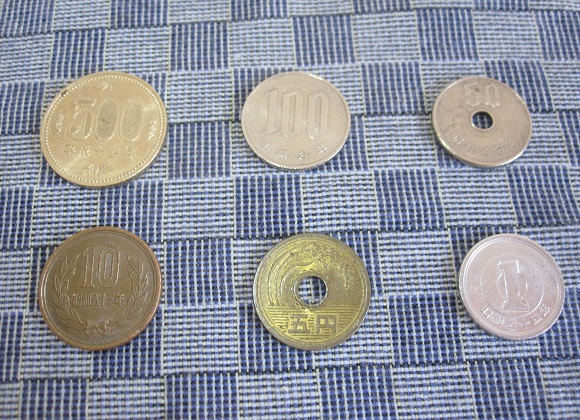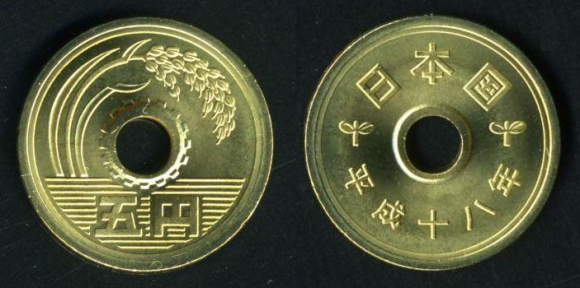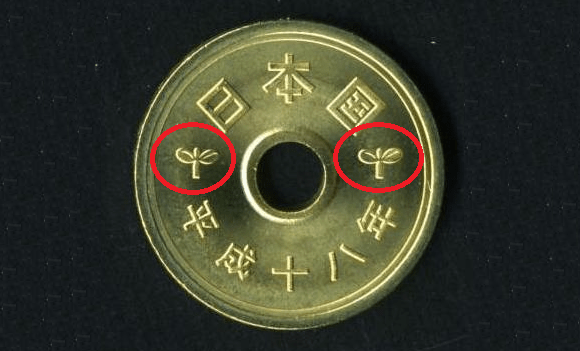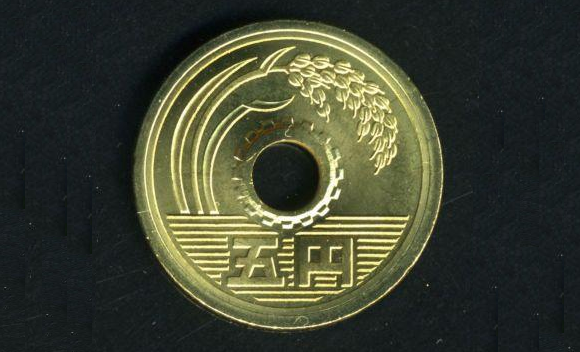
Japanese citizens feel the symbolism-rich coin, which lacks something, can make travel in Japan difficult for foreign guests.
On their first trip to Japan, almost all travelers are struck by how distinct the design of the five-yen coin is. With its bright gold color and prominent hole in the middle, getting a five-yen coin at the money exchange counter or as change when making a purchase makes it feel like the monetary system itself is saying “Welcome to Japan!”
But as indicative of the country as it may be, some Japanese people think the five-yen coin could use a bit of a redesign. Proponents of a change cite personal observations of foreign travelers in stores and on public transportation being confused about how much the coin is worth, and point to one reason why.
The five-yen coin is the only denomination without its value written in numerals. The only indication of its worth is in the kanji characters 五円, which mean “five yen,” and so foreign visitors who can’t read kanji, or who can’t read those two in particular, have no way of determining how much the five-yen coin is worth without prior knowledge. Because of this, some individuals are saying numerals should be added before the 2020 Tokyo Olympics, when the number of foreigners visited Japan is expected to surge.
While we’re taking a close look at the five-yen coin, let’s stop to appreciate all the aspirational philosophy that went into its design, which was adopted in the late 1940s. At the time, Japan was still recovering from the devastating effects of World War II, and so the coin’s designers put two sprouting plants on one face of the coin, to symbolize their hopes that the nation would be making steady progress as it rebuilt itself.
On the other side, the designers placed references to what they felt would be the three pillars of economic recovery. The stalk of rice, symbolizing the nation’s farmers, is hard to miss, but those horizontal lines behind the “five yen” kanji represent the waves of the ocean, as fishing and marine products have always been an important contributor to Japanese life and livelihoods. Finally, on this side of the coin only, the central hole is surrounded by a series of notches like those found on a mechanical gear, as a salute to the nation’s industrial workers and institutions.
With so much meaningful iconography involved, a major overhaul of the five-yen coin’s design seems unlikely. That said, finding space to fit a 5 somewhere within the existing design doesn’t seem like an impossible task, but it may prove to be an unnecessary one. As mentioned above, the gold-colored five-yen coin has a hole, a trait it shares only with the silver-colored 50-yen coin, making the five-yen piece’s combination of shape and color unique among Japan’s coins, so as long as visitors know that Japan has a five-yen coin, it’s not too hard to determine which one it is.
There’s also the fact that vending machines in Japan, in general, don’t accept five-yen coins, and as a result any time you’re in a position to use one, you’ll probably be dealing with a human being, who hopefully can help you overcome the monetary language barrier.
Source: Yahoo! Japan News/J Cast via Otakomu
Top image ©SoraNews24
Insert images: Wikipedia/Misogi (edited by SoraNews24)
Follow Casey on Twitter, where he wonders where he put the five-yen coin from his first trip to Japan that he kept as a souvenir.




 Japan redesigns yen bills and coin, adds beautiful ukiyo-e painting, women’s education pioneer
Japan redesigns yen bills and coin, adds beautiful ukiyo-e painting, women’s education pioneer Japan’s Kanji of the Year revealed, reflects both the good and the bad of 2022
Japan’s Kanji of the Year revealed, reflects both the good and the bad of 2022 Japan unveils beautiful new yen coins for Tokyo Olympics, needs your help picking the best design
Japan unveils beautiful new yen coins for Tokyo Olympics, needs your help picking the best design This amazing suit of samurai armor is made of five-yen coins, and you can make your own too【Pics】
This amazing suit of samurai armor is made of five-yen coins, and you can make your own too【Pics】 Japan issuing beautiful new coins to celebrate Emperor Naruhito’s enthronement
Japan issuing beautiful new coins to celebrate Emperor Naruhito’s enthronement 7-Eleven Japan’s ramen-cooking robot whipped us up a bowl of noodles【Taste test】
7-Eleven Japan’s ramen-cooking robot whipped us up a bowl of noodles【Taste test】 Hello Kitty Choco Egg figures are an adorable trip through three periods of Japanese pop culture【Pics】
Hello Kitty Choco Egg figures are an adorable trip through three periods of Japanese pop culture【Pics】 Can a dirty butthole make you filthy rich in Japan? We’re starting a New Year’s lottery experiment
Can a dirty butthole make you filthy rich in Japan? We’re starting a New Year’s lottery experiment Japan’s otoshidama tradition of giving kids money at New Year’s gets a social welfare upgrade
Japan’s otoshidama tradition of giving kids money at New Year’s gets a social welfare upgrade Lacquerware supplier to emperor of Japan and Pokémon team up for new tableware
Lacquerware supplier to emperor of Japan and Pokémon team up for new tableware We suspected this Japanese cable car was an overpriced tourist trip, but we underestimated it
We suspected this Japanese cable car was an overpriced tourist trip, but we underestimated it New smartphone game lets you date real-life J-pop idols, but shockingly gives them 100 Boyfriends
New smartphone game lets you date real-life J-pop idols, but shockingly gives them 100 Boyfriends Seven unbelievable jobs that actually exist in Japan
Seven unbelievable jobs that actually exist in Japan More people in Japan quit sending New Year’s cards and many have started to regret it
More people in Japan quit sending New Year’s cards and many have started to regret it What’s a furisode kimono without sleeves? An incredibly elegant wedding dress【Photos】
What’s a furisode kimono without sleeves? An incredibly elegant wedding dress【Photos】 7-Eleven Japan starts new temporary luggage storage service in over 300 branches
7-Eleven Japan starts new temporary luggage storage service in over 300 branches Disillusionment at Tsukiji’s tourist-target prices led us to a great ramen restaurant in Tokyo
Disillusionment at Tsukiji’s tourist-target prices led us to a great ramen restaurant in Tokyo Starbucks teams up with 166-year-old Kyoto doll maker for Year of the Horse decorations【Photos】
Starbucks teams up with 166-year-old Kyoto doll maker for Year of the Horse decorations【Photos】 Japan may add Japanese language proficiency, lifestyle classes to permanent foreign resident requirements
Japan may add Japanese language proficiency, lifestyle classes to permanent foreign resident requirements Starbucks Japan releases new zodiac chilled cup drink for 2026
Starbucks Japan releases new zodiac chilled cup drink for 2026 Tokyo’s Tsukiji sushi neighborhood asks tour groups to stay away for the rest of the month
Tokyo’s Tsukiji sushi neighborhood asks tour groups to stay away for the rest of the month Is this the most relaxing Starbucks in Japan?
Is this the most relaxing Starbucks in Japan? Starbucks on a Shinkansen bullet train platform: 6 tips for using the automated store in Japan
Starbucks on a Shinkansen bullet train platform: 6 tips for using the automated store in Japan Street Fighter Hadouken Churros to be launched and eaten in Tokyo, Okami pudding on offer too
Street Fighter Hadouken Churros to be launched and eaten in Tokyo, Okami pudding on offer too Japan’s human washing machines will go on sale to general public, demos to be held in Tokyo
Japan’s human washing machines will go on sale to general public, demos to be held in Tokyo Japanese train company is letting fans buy its actual ticket gates for their homes
Japanese train company is letting fans buy its actual ticket gates for their homes Tokyo considering law requiring more trash cans following litter increase in heavily touristed area
Tokyo considering law requiring more trash cans following litter increase in heavily touristed area Nintendo’s Kirby now delivering orders at Kura Sushi restaurants, but not in Japan
Nintendo’s Kirby now delivering orders at Kura Sushi restaurants, but not in Japan Tokyo event lets you travel back in time, for free, to celebrate 100 years since Showa era start
Tokyo event lets you travel back in time, for free, to celebrate 100 years since Showa era start Sanrio theme park in Japan announces plans to expand into a Sanrio resort
Sanrio theme park in Japan announces plans to expand into a Sanrio resort Survey asks foreign tourists what bothered them in Japan, more than half gave same answer
Survey asks foreign tourists what bothered them in Japan, more than half gave same answer Japan’s deadliest food claims more victims, but why do people keep eating it for New Year’s?
Japan’s deadliest food claims more victims, but why do people keep eating it for New Year’s? We deeply regret going into this tunnel on our walk in the mountains of Japan
We deeply regret going into this tunnel on our walk in the mountains of Japan Studio Ghibli releases Kodama forest spirits from Princess Mononoke to light up your home
Studio Ghibli releases Kodama forest spirits from Princess Mononoke to light up your home Major Japanese hotel chain says reservations via overseas booking sites may not be valid
Major Japanese hotel chain says reservations via overseas booking sites may not be valid Put sesame oil in your coffee? Japanese maker says it’s the best way to start your day【Taste test】
Put sesame oil in your coffee? Japanese maker says it’s the best way to start your day【Taste test】 The top 10 annoying foreign tourist behaviors on trains, as chosen by Japanese people【Survey】
The top 10 annoying foreign tourist behaviors on trains, as chosen by Japanese people【Survey】 No more using real katana for tourism activities, Japan’s National Police Agency says
No more using real katana for tourism activities, Japan’s National Police Agency says Starbucks Japan reveals new sakura drinkware collection, inspired by evening cherry blossoms
Starbucks Japan reveals new sakura drinkware collection, inspired by evening cherry blossoms Japan’s 500-yen coin has two hidden messages, and here’re where to find them 【Photos】
Japan’s 500-yen coin has two hidden messages, and here’re where to find them 【Photos】 Busting one of the biggest myths about the five-yen coin and shrine offerings in Japan
Busting one of the biggest myths about the five-yen coin and shrine offerings in Japan Awe-inspiring coin sculpture erected during boring holiday
Awe-inspiring coin sculpture erected during boring holiday Japan’s Kanji of the Year announced, shows the bright and dark spots of 2024【Video】
Japan’s Kanji of the Year announced, shows the bright and dark spots of 2024【Video】 Why does Japanese writing need three different sets of characters? (Part 2)
Why does Japanese writing need three different sets of characters? (Part 2) Silver 1,000 yen coin to be issued for Shinkansen’s 50th anniversary
Silver 1,000 yen coin to be issued for Shinkansen’s 50th anniversary Japan’s kanji character of the year for 2017 is “north”
Japan’s kanji character of the year for 2017 is “north” Why was the 2,000-yen bill left out of Japan’s yen redesign, and how does it feel about the snub?
Why was the 2,000-yen bill left out of Japan’s yen redesign, and how does it feel about the snub? How many rare coins are in our pile of 100,000 one-yen coins?
How many rare coins are in our pile of 100,000 one-yen coins? In Japan, one yen coins don’t get picked up by strangers in public – they multiply instead
In Japan, one yen coins don’t get picked up by strangers in public – they multiply instead Japan’s Kanji of the Year for 2023 reveals the worries of Japanese society
Japan’s Kanji of the Year for 2023 reveals the worries of Japanese society Foreigners in Japan vote for the best-looking katakana character
Foreigners in Japan vote for the best-looking katakana character W.T.F. Japan: Top 5 kanji with ironic meanings【Weird Top Five】
W.T.F. Japan: Top 5 kanji with ironic meanings【Weird Top Five】 W.T.F. Japan: Top 5 most confusing Japanese compound words【Weird Top Five】
W.T.F. Japan: Top 5 most confusing Japanese compound words【Weird Top Five】 German linguist living in Japan says kanji characters used for Germany are discriminatory
German linguist living in Japan says kanji characters used for Germany are discriminatory Top Japanese baby names for 2025 feature flowers, colors, and a first-time-ever favorite for girls
Top Japanese baby names for 2025 feature flowers, colors, and a first-time-ever favorite for girls
Leave a Reply